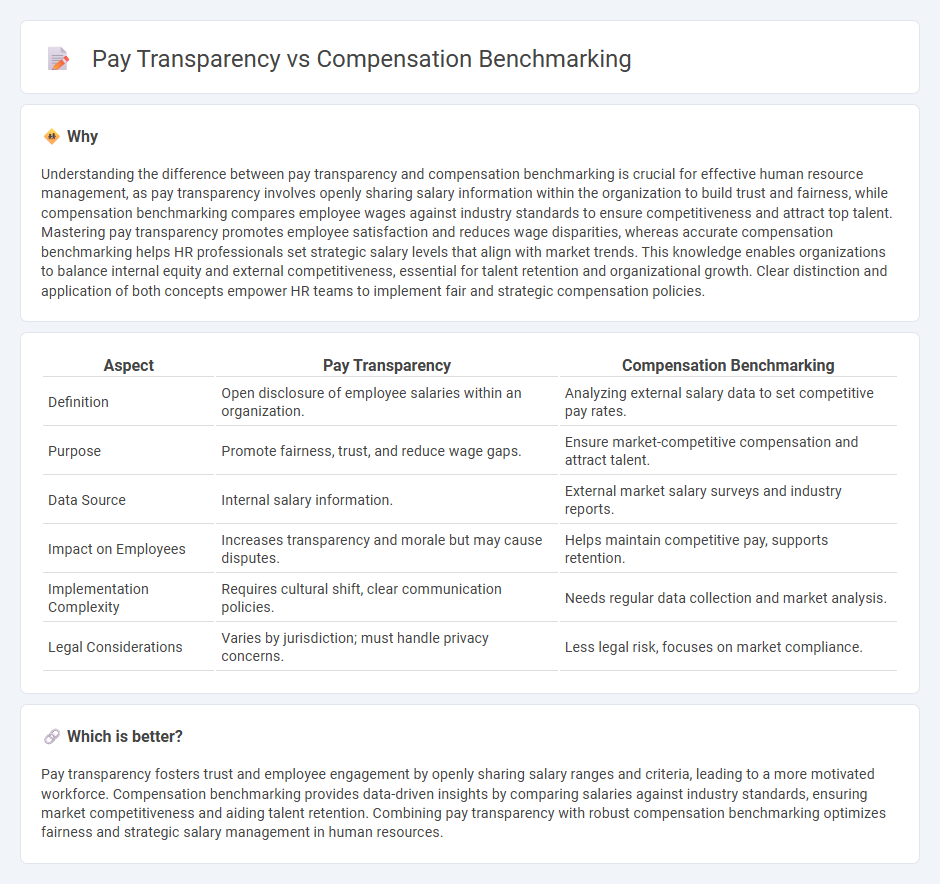
Pay transparency fosters trust and equity by openly sharing salary information within organizations, while compensation benchmarking ensures competitive and fair pay by analyzing market salary data. Both strategies play crucial roles in attracting and retaining top talent by aligning employee expectations with industry standards. Explore how integrating pay transparency with compensation benchmarking can optimize your human resources strategy.
Why it is important
Understanding the difference between pay transparency and compensation benchmarking is crucial for effective human resource management, as pay transparency involves openly sharing salary information within the organization to build trust and fairness, while compensation benchmarking compares employee wages against industry standards to ensure competitiveness and attract top talent. Mastering pay transparency promotes employee satisfaction and reduces wage disparities, whereas accurate compensation benchmarking helps HR professionals set strategic salary levels that align with market trends. This knowledge enables organizations to balance internal equity and external competitiveness, essential for talent retention and organizational growth. Clear distinction and application of both concepts empower HR teams to implement fair and strategic compensation policies.
Comparison Table
| Aspect | Pay Transparency | Compensation Benchmarking |
|---|---|---|
| Definition | Open disclosure of employee salaries within an organization. | Analyzing external salary data to set competitive pay rates. |
| Purpose | Promote fairness, trust, and reduce wage gaps. | Ensure market-competitive compensation and attract talent. |
| Data Source | Internal salary information. | External market salary surveys and industry reports. |
| Impact on Employees | Increases transparency and morale but may cause disputes. | Helps maintain competitive pay, supports retention. |
| Implementation Complexity | Requires cultural shift, clear communication policies. | Needs regular data collection and market analysis. |
| Legal Considerations | Varies by jurisdiction; must handle privacy concerns. | Less legal risk, focuses on market compliance. |
Which is better?
Pay transparency fosters trust and employee engagement by openly sharing salary ranges and criteria, leading to a more motivated workforce. Compensation benchmarking provides data-driven insights by comparing salaries against industry standards, ensuring market competitiveness and aiding talent retention. Combining pay transparency with robust compensation benchmarking optimizes fairness and strategic salary management in human resources.
Connection
Pay transparency fosters trust and boosts employee morale by openly sharing salary information, which directly influences a company's approach to compensation benchmarking. Compensation benchmarking uses market data to set competitive salary ranges, ensuring fairness and equity within the organization while aligning with industry standards. This connection enhances talent attraction and retention by promoting equitable pay practices based on transparent, data-driven comparisons.
Key Terms
Market Rate Analysis
Market rate analysis is a critical component in compensation benchmarking, providing data-driven insights into competitive salary ranges across industries and roles. Pay transparency leverages this analysis by openly sharing compensation information within organizations to foster trust and equity. Explore how market rate analysis enhances pay transparency and drives strategic compensation decisions.
Salary Disclosure
Salary disclosure in compensation benchmarking provides organizations with critical data to align pay scales competitively within industry standards, ensuring equitable and market-driven salary structures. Pay transparency fosters employee trust and engagement by openly communicating salary ranges and criteria, reducing wage gaps and enhancing workforce morale. Explore how these strategies impact talent attraction and retention in today's evolving labor market.
Pay Equity
Compensation benchmarking involves comparing salaries within an industry to ensure competitive pay, while pay transparency openly shares compensation data to promote fairness and trust. Both strategies aim to support pay equity by identifying and reducing wage gaps among employees based on gender, race, or role. Explore how combining benchmarking and transparency can create a more equitable pay structure in your organization.
Source and External Links
Salary Benchmarking for Startups - Compensation - Salary benchmarking is the process of comparing your company's employee compensation (salary, equity, and benefits) against market data, using clear job definitions, reliable data sources, and structured salary bands to ensure fair, transparent, and competitive pay structures.
Salary Benchmarking: Steps, Best Practices, and Tips - Compensation benchmarking involves matching your company's roles to those in peer organizations and considering factors like industry standards, location, economic conditions, skill demand, company size, performance, and legal requirements to set competitive and equitable pay levels.
Compensation 101: establishing a benchmark methodology - Salary benchmarking (or market pricing) is a systematic method for identifying comparable jobs in market surveys, analyzing their pay rates, and clustering jobs into coherent salary structures to guide internal compensation decisions.
 dowidth.com
dowidth.com